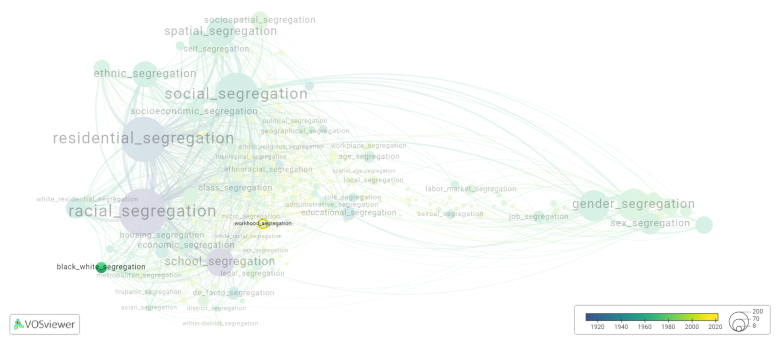Workhood segregation: Difference between revisions
(Creating page) |
(Creating page) |
||
| (One intermediate revision by the same user not shown) | |||
| Line 16: | Line 16: | ||
[[File:workhood_segregation.png|780x780px]] | [[File:workhood_segregation.png|780x780px]] | ||
This visualization is based on the study [[Segregation_Wiki:About| The Multidisciplinary Landscape of Segregation Research]]. | |||
For the complete network of | For the complete network of interrelated segregation forms, please refer to: | ||
* | * [https://tinyurl.com/2235lkhw First year of publication] | ||
* | * [https://tinyurl.com/2d8wg5n3 Louvain clusters] | ||
* | * [https://tinyurl.com/223udk5r Betweenness centrality] | ||
* | * [https://tinyurl.com/244d8unz Disciplines in which segregation forms first emerged (Scopus database).] | ||
==References== | ==References== | ||
==Notes== | ==Notes== | ||
Latest revision as of 07:17, 16 October 2024
Date and country of first publication[1][edit | edit source]
2019
United States
Definition[edit | edit source]
Workplace segregation refers to the division of employees based on certain characteristics such as gender, race, age, ethnicity, and even job positions within a company. It can occur through intentional or unintentional practices that result in certain groups of people being concentrated in specific roles or departments within an organization.
Workplace segregation can have negative consequences, including limiting opportunities for individuals from marginalized groups, perpetuating inequalities, and hindering diversity and inclusion efforts. It can also contribute to a lack of representation and limited perspectives within decision-making processes and leadership positions.
Efforts to combat workplace segregation include promoting diversity and inclusion initiatives, implementing fair and unbiased hiring practices, providing equal opportunities for career advancement, and fostering an inclusive work culture that values and celebrates diversity.
See also[edit | edit source]
Related segregation forms[edit | edit source]
Workhood segregation is frequently discussed in the literature with the following segregation forms:
residential segregation, social segregation, racial segregation, metropolitan segregation, black white segregation, work segregation

This visualization is based on the study The Multidisciplinary Landscape of Segregation Research.
For the complete network of interrelated segregation forms, please refer to:
References[edit | edit source]
Notes[edit | edit source]
- ↑ Date and country of first publication as informed by the Scopus database (December 2023).
At its current state, this definition has been generated by a Large Language Model (LLM) so far without review by an independent researcher or a member of the curating team of segregation experts that keep the Segregation Wiki online. While we strive for accuracy, we cannot guarantee its reliability, completeness and timeliness. Please use this content with caution and verify information as needed. Also, feel free to improve on the definition as you see fit, including the use of references and other informational resources. We value your input in enhancing the quality and accuracy of the definitions of segregation forms collectively offered in the Segregation Wiki ©.
Workhood segregation appears in the following literature[edit | edit source]
Hall M., Iceland J., Yi Y. (2019). Racial Separation at Home and Work: Segregation in Residential and Workplace Settings. Population Research and Policy Review, 38(5), 671-694. Springer Netherlands.https://doi.org/10.1007/s11113-019-09510-9
Hall M., Iceland J., Yi Y. (2019). Racial Separation at Home and Work: Segregation in Residential and Workplace Settings. Population Research and Policy Review, 38(5), 671-694. Springer Netherlands.https://doi.org/10.1007/s11113-019-09510-9
